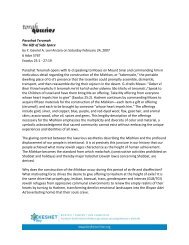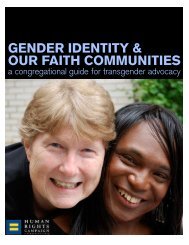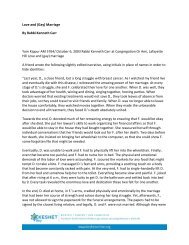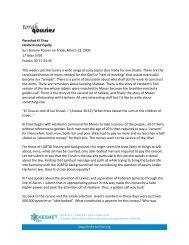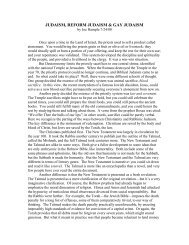Parashat B'reshit B'reshit and bashert: in our beginning, all ... - Keshet
Parashat B'reshit B'reshit and bashert: in our beginning, all ... - Keshet
Parashat B'reshit B'reshit and bashert: in our beginning, all ... - Keshet
Create successful ePaper yourself
Turn your PDF publications into a flip-book with our unique Google optimized e-Paper software.
<strong>Parashat</strong> <strong>B'reshit</strong><br />
<strong>B'reshit</strong> <strong>and</strong> <strong>bashert</strong>: <strong>in</strong> <strong>our</strong> beg<strong>in</strong>n<strong>in</strong>g, <strong>all</strong> k<strong>in</strong>ds of love were sanctified<br />
by Amy Soule on Friday October 16, 2009<br />
28 Tishrei 5770<br />
Genesis 1:1 - 6:8<br />
So God created humank<strong>in</strong>d <strong>in</strong> God’s own image; <strong>in</strong> the image of God humanity was created;<br />
male <strong>and</strong> female God created them. (Genesis 1:27)<br />
Perhaps my friends laugh at me when they hear that B’reishit is one of my fav<strong>our</strong>ite Torah<br />
portions because so many times strict religious people look toward certa<strong>in</strong> segments to judge<br />
me as gay, but it’s easy for me to expla<strong>in</strong> myself.<br />
Look hard at the holy, lov<strong>in</strong>g statement above. Genesis 1:27 states <strong>all</strong> of humank<strong>in</strong>d was<br />
created <strong>in</strong> God’s image. Although it mentions sexual difference alone, it’s easy to extrapolate<br />
<strong>and</strong> thus expla<strong>in</strong> that God created an array of sexual orientations, <strong>all</strong> of which are loved by God<br />
<strong>and</strong> holy.<br />
It also gives us a couple teach<strong>in</strong>gs about sex. If read accord<strong>in</strong>g to the traditional mean<strong>in</strong>g, we<br />
can look at it to mean that women are equal to men s<strong>in</strong>ce they were created simultaneously<br />
God.<br />
A second underst<strong>and</strong><strong>in</strong>g helps affirm <strong>in</strong>tersex people too. If male <strong>and</strong> female anatomies were<br />
created together then people blessed to have both k<strong>in</strong>ds of anatomy shouldn’t be treated like<br />
“freaks of nature”, as they tend to be <strong>in</strong> <strong>our</strong> so-c<strong>all</strong>ed “modern” society, someth<strong>in</strong>g the Talmud<br />
underst<strong>and</strong>s too.<br />
In the Mishnah, Rabbi Yosi makes the radical statement: <strong>and</strong>rogynos (a term for a dual-sex<br />
human which some have recognized as similar to today’s term for <strong>in</strong>tersex) bria bifnei atzma hu<br />
/ the <strong>and</strong>rogynos (<strong>in</strong>tersex human) he is a created be<strong>in</strong>g of her own.” His Hebrew expression<br />
blends male <strong>and</strong> female pronouns to express the complexity of the <strong>and</strong>rogynos’ identity <strong>in</strong> a<br />
very poetic way.<br />
Furthermore, the Hebrew word bria (created be<strong>in</strong>g) explicitly refers to div<strong>in</strong>e formation; hence<br />
this term also rem<strong>in</strong>ds us that <strong>all</strong> bodies are created <strong>in</strong> the image of God, as clearly stated <strong>in</strong> <strong>our</strong><br />
Torah portion.
God blessed them… (Genesis 1:28)<br />
Accord<strong>in</strong>g to the Midrash (Genesis Rabbah 8:13), this bless<strong>in</strong>g <strong>in</strong>dicates that God officiated at<br />
Eve <strong>and</strong> Adam’s wedd<strong>in</strong>g. Some might throw this aga<strong>in</strong>st us as “proof” that God only blesses<br />
straight love, but it can mean much more. Adam <strong>and</strong> Eve are only one example of love <strong>and</strong><br />
marriage. Perhaps I’m deviat<strong>in</strong>g from <strong>our</strong> text right now, but the Tanach gives examples of<br />
other k<strong>in</strong>ds of love (<strong>and</strong> perhaps wedd<strong>in</strong>g ceremonies).<br />
If we look at the story of Ruth <strong>and</strong> Naomi, we see echoes of <strong>our</strong> Torah portion, where it is<br />
stated men cl<strong>in</strong>g to their spouses. If we look at Ruth 1:14, we read that Orpah kissed Naomi but<br />
Ruth clung to her. Sure, Ruth marries Boaz later <strong>in</strong> the story, but it seems a little bit like a<br />
marriage of convenience to ensure she <strong>and</strong> Naomi don’t have to worry about money <strong>and</strong> can<br />
live their lives together as they want to. They are relatives (mother <strong>and</strong> daughter-<strong>in</strong>-law) but<br />
their relationship has always struck me as deeper.<br />
Look at this:<br />
Don’t urge me to leave you or to turn back from you. Where you go I will go, <strong>and</strong> where you<br />
stay I will stay. Y<strong>our</strong> people will be my people <strong>and</strong> y<strong>our</strong> God my God. Where you die I will die,<br />
<strong>and</strong> there I will be buried. May God deal with me, be it ever so severely, if anyth<strong>in</strong>g but death<br />
separates you <strong>and</strong> me (Ruth 1:16-17).<br />
I’m very aware these l<strong>in</strong>es have always been viewed as Ruth’s conversion to Judaism <strong>and</strong><br />
<strong>in</strong>spired many who have converted, but to be honest her conversion is hardly remarkable.<br />
Mov<strong>in</strong>g, <strong>in</strong> Biblical times, often meant worshipp<strong>in</strong>g different gods <strong>and</strong> goddesses.<br />
Instead, these l<strong>in</strong>es of Scripture seem to represent a wedd<strong>in</strong>g vow. They are so popular at<br />
wedd<strong>in</strong>g <strong>and</strong> commitment ceremonies for gay women that, accord<strong>in</strong>g to Ceremonies of the<br />
Heart (an anthology of lesbian commitment ceremonies conducted twenty-some years ago),<br />
they were assumed to be st<strong>and</strong>ard for any religious (Jewish or Christian) affirmation of love<br />
between women.<br />
Gay men can look to the Tanach for an example of a marriage ceremony too. 1 Samuel 18:1-4<br />
reads like this:<br />
When David had f<strong>in</strong>ished speak<strong>in</strong>g to Saul, the soul of Jonathan was bound to the soul of David,<br />
<strong>and</strong> Jonathan loved him as his own soul. Saul took him that day <strong>and</strong> would not let him return to<br />
his father’s house. Then Jonathan made a covenant with David, because he loved him as his
own soul. Jonathan stripped himself of the robe that he was wear<strong>in</strong>g, <strong>and</strong> gave it to David, <strong>and</strong><br />
his arm<strong>our</strong>, <strong>and</strong> even his sword <strong>and</strong> his bow <strong>and</strong> his belt.”<br />
Here we have an explicit reference to gay love. Others may attempt to water down everyth<strong>in</strong>g<br />
<strong>and</strong> rem<strong>in</strong>d everyone that David was <strong>in</strong>volved <strong>in</strong> relationships with women but it seems crystal<br />
clear. Two men are <strong>in</strong>volved <strong>in</strong> a covenant of love.<br />
They rema<strong>in</strong> devoted to each other <strong>and</strong> <strong>in</strong> m<strong>our</strong>n<strong>in</strong>g Jonathon, David clarifies everyth<strong>in</strong>g to<br />
ensure readers don’t wonder about his sexuality (s<strong>in</strong>ce he had relationships with women too):<br />
I’m very distressed for you my brother Jonathan; Greatly beloved were you to me; y<strong>our</strong> love to<br />
me was wonderful, pass<strong>in</strong>g the love of women. (2 Samuel 1:26).<br />
He might have cared, on some level, for women (mak<strong>in</strong>g him bisexual) but his dom<strong>in</strong>ant feel<strong>in</strong>g<br />
was toward men (perhaps a 5 on the K<strong>in</strong>sey scale).<br />
No matter <strong>our</strong> underst<strong>and</strong><strong>in</strong>g <strong>and</strong> <strong>in</strong>terpretation of the stories of Ruth/Naomi <strong>and</strong><br />
David/Jonathon, they have great potential to prove <strong>all</strong> love is holy <strong>and</strong> affirmed by God.<br />
Perhaps the Baal Shem Tov, the founder of classical Hasidism, said it best (ironic as that might<br />
seem) :<br />
From every human be<strong>in</strong>g there rises a light that reaches straight to heaven. When two souls are<br />
dest<strong>in</strong>ed to be together f<strong>in</strong>d each other, their streams of light flow together <strong>and</strong> a s<strong>in</strong>gle<br />
brighter light emanates from their united be<strong>in</strong>g.<br />
It st<strong>and</strong>s to reason the Baal Shem Tov couldn’t have foreseen that his words might become an<br />
affirmation of <strong>all</strong> k<strong>in</strong>ds of love, but his language is generic. He doesn’t state “When a man <strong>and</strong> a<br />
woman f<strong>in</strong>d each other…” He leaves his remark open to everyone, perhaps an early<br />
acknowledgement that there are multiple ways to love <strong>and</strong> <strong>all</strong> of them can be kiddushim.<br />
When I was younger, I sometimes confused the words <strong>bashert</strong> <strong>and</strong> b’reishit. Now, hav<strong>in</strong>g<br />
completely grasped their dist<strong>in</strong>ct mean<strong>in</strong>gs, I’m happy to comb<strong>in</strong>e them <strong>in</strong> a coherent, affirm<strong>in</strong>g<br />
way, assert<strong>in</strong>g that <strong>in</strong> the beg<strong>in</strong>n<strong>in</strong>g God created people differently <strong>and</strong> that <strong>our</strong> besherts can<br />
be anyone, whether same, opposite or both sexes. No matter where we look, whether to the<br />
Torah, other places with<strong>in</strong> the Tanach, the legal sections of the Talmud or even to the teach<strong>in</strong>g<br />
of a Hasidic leader many centuries ago, <strong>our</strong> religious tradition has <strong>all</strong> k<strong>in</strong>ds of holy affirmations<br />
that we can look toward whenever we are feel<strong>in</strong>g alone <strong>and</strong> <strong>in</strong> need of a rem<strong>in</strong>der that we are<br />
God’s <strong>and</strong> created b’tezelem Elohim.




